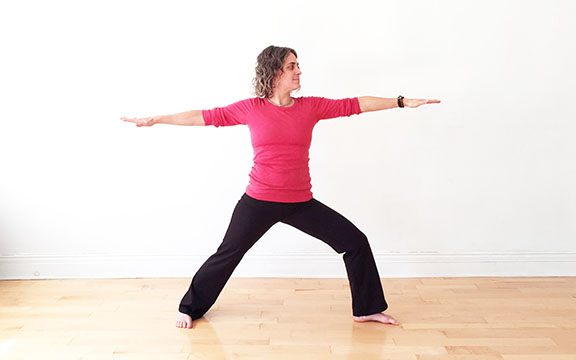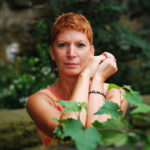In The Yoga Sutras of Patanjali, Book II: sutra 46, Sri Patanjali describes asana as having two components: sthira—steady, sukham—comfortable. Swami Satchidananda’s commentary on this sutra tells us that “We need the strength of steel, but with steel’s flexibility.” How might one experience the idea expressed in this analogy?
Exploration of Sthira
Often in the Sanskrit language words have multiple meanings. Sthira’s meaning can be explored from a foundational approach to mean “stability.” It requires strength to be stable. Stability plays a vital role in determining whether we feel comfortable. Stability offers security, strength, and skill. Without security our comfort level is challenged—whether it has to do with asana, delivering a speech, or even building a structure. When looking at asana, we are building a structure with our bodies that we call a posture. To skillfully “build” a posture one begins with the foundation.
Exploration of Sukham
In order to better understand the meaning of sukham, as related to our comfort level in an asana, we can dissect the word sukham. Su literally means “good.” Kha literally means “space.” Therefore, the foundational meaning of sukham means “good space.” Comfort is the state of physical ease which could also be thought of as mobility. Being able means to have skill or strength. When one is comfortable, he or she is in a good space. If one is in a good space there is physical ease, mobility, and even liberation. And that ease comes from stability.
Looking for Stability in all the Wrong Places

Collapsed asana
Often as teachers, we see students attempting to stabilize themselves in a posture, not from what lies below, but rather from above, such as in Virabhadrasana II. Too often students attempt to hold themselves up from their shoulders causing rigidity in the mobile, or the more sukham part of the body—the body that is ingeniously built for stability—which is comprised of the pelvis, thighs, legs, and feet. When there is a collapse in what best serves as sthira, everything above is compromised.For example, the front leg sways inward, and the back leg loses its foundation. The trunk of the body sinks into the hip joints. The lumbar spine is compressed, adversely affecting the sacroiliac joints and the ribcage juts forward. Meanwhile, the arms and shoulders are working really hard and become overtaxed with too much effort. Inevitably, the shoulders hunch up by the ears, the jaw clenches, and the manifestation of the asana is restricted. Because of the dis-ease of the pose, the breath is compromised and consequently the prana; not unlike when a large rock is placed in the middle of a flowing stream, interrupting its smooth flow.

Corrected asana
Putting it All Together
Begin with foundational sthira—stability, the foundation of the body (the feet) related to the foundation below the feet (the Earth). Connect and feel secure with the foundational structure and settle into the good space, the sukham. Bring the attention to your spine. The spine is architecturally designed to support both sthira (on the anterior side of the spine) and sukham (on the posterior side of the spine). In Hatha Yoga practice, when one finds the relationship between stability and mobility, or good space, then the asana embodies the sutra: sthira sukham asanam. One literally experiences steadiness and comfort. The strength is as strong as steel with the flexibility of the steel. Sthira sukham asanam allows the prana to flow easily or without inhibition. When prana flows effortlessly, there is ease in the mind/body. When there is ease, one may feel calm, peaceful, and more present. If a pose is steady and comfortable, then and only then is the pose truly useful.
About the Teachers:
 Kali Morse, E-RYT 500, RPYT, C-IAYT, is director of the Teacher Training programs at the Integral Yoga Institute of New York. Kali’s dedication and service to the art and science of Yoga spans four decades. She has taught Yoga in many settings including schools, colleges, hospitals, businesses, etc. She is certified to teach Integral Hatha Levels I, II, and III, Meditation, Raja Yoga, Prenatal and Postnatal Yoga, Children’s Yoga, and Therapeutic Yoga.
Kali Morse, E-RYT 500, RPYT, C-IAYT, is director of the Teacher Training programs at the Integral Yoga Institute of New York. Kali’s dedication and service to the art and science of Yoga spans four decades. She has taught Yoga in many settings including schools, colleges, hospitals, businesses, etc. She is certified to teach Integral Hatha Levels I, II, and III, Meditation, Raja Yoga, Prenatal and Postnatal Yoga, Children’s Yoga, and Therapeutic Yoga.
 Rashmi Galliano, E-RYT 500, RPYT, is a certified Hatha II, Hatha III, Gentle, and Prenatal Integral Yoga teacher and has been teaching since 2006. She is one of Integral Yoga’s senior teacher trainers, and is on the teaching staff of the Integral Yoga Institute of New York. Rashmi is also certified as a teacher of Prana Yoga with Jeff Migdow, M.D., through the Open Center in New York City; of Vinyasa Yoga with Stephanie Keach in Asheville, North Carolina; of Yoga Anatomy with Leslie Kaminoff at the Breathing Project in New York City; and of “Relax and Renew” Yoga through Judith Lasater. She has training in Reiki levels 1 and 2 from Tom Capshew.
Rashmi Galliano, E-RYT 500, RPYT, is a certified Hatha II, Hatha III, Gentle, and Prenatal Integral Yoga teacher and has been teaching since 2006. She is one of Integral Yoga’s senior teacher trainers, and is on the teaching staff of the Integral Yoga Institute of New York. Rashmi is also certified as a teacher of Prana Yoga with Jeff Migdow, M.D., through the Open Center in New York City; of Vinyasa Yoga with Stephanie Keach in Asheville, North Carolina; of Yoga Anatomy with Leslie Kaminoff at the Breathing Project in New York City; and of “Relax and Renew” Yoga through Judith Lasater. She has training in Reiki levels 1 and 2 from Tom Capshew.
Disclaimer: We offer only information and no medical advice. You should consult a medical practitioner before starting any new exercise regime. This is particularly important if you are overweight, pregnant, nursing, regularly taking medications, or have any existing medical conditions. This article may not be tailored to your current physical and mental health. We accept no liability whatsoever for any damages arising from the use of this article or website.

